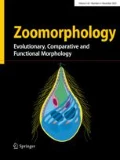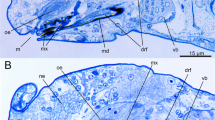Abstract
Ophryotrocha labronica, as typical for Eunicida, has a complex jaw apparatus consisting of ventral mandibles and dorsal maxillae. Mandibles are not replaced but are retained throughout life. Larval mandibles have adult-sized cutting plates but their proximal shafts lengthen and enlarge as the worm grows. The maxillary apparatus of O. labronica undergoes three moults or replacements. The initial, or larval maxillae, consisting of two paired basal plates and two paired free denticles, develop in the unreleased larvae. They are replaced in the 5-setiger juvenile by the P1-maxillae consisting of falcate forceps and six denticles. The second moult occurs in the 8- to 9-setiger juveniles and results in the P2-maxillae with bidentate forceps and seven denticles, and the third and final moult results in the K-maxillae and seven denticles. The K-maxillae develop in 9- to 12-setiger males and 13- to 15-setiger females and are not replaced but enlarge proximally. Thus the K-forceps can be traced back through the P2-forceps, P1-forceps, to the larval basal plates, indicating the apomorphic state of the K-forceps. Three pulp cavities, separated by darker fusion lines are visible in weakly sclerotised young K-forceps suggesting the fusion of three separate elements. It is concluded that the Ophryotrocha forceps are homologous to the superior and probably inferior basal plates of other dorvilleids. The internal structure of the Ophryotrocha forceps demonstrates that they are not homologous to the labidognath maxilla I as has been suggested.





Similar content being viewed by others
References
Åkesson B (1970) Ophryotrocha labronica as test animal for the study of marine pollution. Helgol Meeresunters 20:293–303
Åkesson B (1973) Reproduction and larval morphology of five Ophryotrocha species (Polychaeta, Dorvilleidae). Zool Scr 2:145–155
Bonnier J (1893) Notes sur les annélides du Boulonnais. I. L’Ophryotrocha puerilis (Claparède et Metschnikoff) et son appareil maxillaire. Bull Biol Fr 25:198–226
Damas D (1987) Etude cytologique, histochimique et microanalytique des pièces maxillaires d’Ophryotrocha puerilis Annélide, Polychète, Eunicidae). Bull Zool Fr 111:61–73
Dohle W (1967) Zur Morphologie und Lebensweise von Ophryotrocha gracilis Huth, 1934 (Polychaeta, Eunicidae). Kieler Meeresf 23:68–74
Eibye-Jacobsen D, Kristensen RM (1994) A new genus and species of Dorvilleidae (Annelida, Polychaeta) from Bermuda, with a phylogenetic analysis of Dorvilleidae, Iphitimidae and Dinophilidae. Zool Scr 23:107–131
Eriksson M, Lindström S (2000) Ophryotrocha sp., the first report of a jawed polychaete from the Cretaceous of Skåne, Sweden. Acta Palaeont Pol 45:311–315
Hartmann M, Huth W (1936) Untersuchungen über Geschlechtsbestimmung und Geschlechtsumwandllung von Ophryotrocha puerilis. Zool Jahrb Physiol 56:389–439
Hilbig B, Blake JA (1991) Dorvilleidae (Annelida: Polychaeta) from the US Atlantic slope and rise. Description of two new genera and 14 new species, with a generic revision of Ophryotrocha. Zool Scr 20:147–183
Jumars PA (1974) A generic revision of the Dorvilleidae (Polychaeta), with six new species from the deep North Pacific. Zool J Linn Soc 54:101–135
Kegel B, Pfannenstiel H-D (1983) Evaluation of the pair-culture effect in Ophryotrocha puerilis (Polychaeta: Dorvilleidae). II. Conditions for the moult of the upper jaw. Helgol Meeresunters 36:215–222
Korschelt E (1894) Über Ophryotrocha puerilis Clap.-Metschn. und die polytrochen Larven eines anderen Anneliden (Harpochaeta cingulata nov. gen., nov. spec.). Z Wiss Zool 57:224–289
Müller H (1962) Über die Sexualität des Polychaeten Ophryotrocha puerilis, ihre Determination und ihren Einfluss auf Drüsentätigkeit und Kauapparatentwicklung. Z Morphol Ökol Tiere 52:1–32
Orensanz JM (1990) The eunicemorph polychaete annelids from Antarctic and Subantarctic seas. With addenda to the Eunicemorpha of Argentina, Chile, New Zealand, Australia, and the southern Indian Ocean. In: Kornicker LS (ed) Biology of the Antarctic seas 21, Antarctic Research Series 52. American Geophysical Union, Washington, DC, pp 1–183
Oug E (1978) New and lesser known Dorvilleidae (Annelida, Polychaeta) from Scandinavian and northeast American waters. Sarsia 63:285–303
Paxton H (1980) Jaw growth and replacement in Polychaeta. J Nat Hist 14:543–546
Paxton H (2000) Eunicida. In: Beesley PL, Ross GJB, Glasby CJ (eds) Polychaetes and allies: the southern synthesis. Fauna of Australia, vol 4A. Polychaeta, Myzostomida, Pogonophora, Echiura, Sipuncula. CSIRO Publishing, Melbourne, pp 89–106
Purschke G (1987) Anatomy and ultrastructure of ventral pharyngeal organs and their phylogenetic importance in Polychaeta (Annelida). IV. The pharynx and jaws of the Dorvilleidae. Acta Zool 68:83–105
Sudzuki M, Sekiguchi K (1972) Some remarks on five aberrant annelids from the culture water of Japanese horse-shoe crabs. Sci Rep Tokyo Kyoiku Daigaku Sect B 15:39–56
Szaniawski H, Wrona R (1987) Polychaete jaws from the Cape Melville formation (Lower Miocene) of King George Island, West Antarctica. Palaeont Pol 49:105–125
Tzetlin AB (1980) Ophryotrocha schubravyi sp. n. and the problem of evolution of the mouth parts in the Eunicemorpha (Polychaeta) (in Russian). Zool J Acad Nauk SSSR 59:666–676
Wolf G (1980) Morphologische Untersuchungen an den Kieferapparaten einiger rezenter und fossiler Eunicoidea (Polychaeta). Senckenbergiana Marit 12:1–182
Zavarzina EG, Tzetlin AB (1986) Biology of Ophryotrocha dimorphica sp. n. (Polychaeta, Eunicida) from the Peter The Great Bay (The Japan Sea) (in Russian). Zool J Acad Nauk SSSR 65:1808–1817
Acknowledgements
I am indebted to Prof. Bertil Åkesson, Department of Zoology, University of Göteborg, for providing the initial culture specimens and Dr. Alexander B. Tzetlin, Biological Faculty, State University of Moscow, for translations and unpublished information. Many thanks go to Mr. Ron Oldfield, Microscopy Unit, for photography and Ms Lesleyanne Kilkeary for technical assistance. I am grateful to the reviewers for their helpful comments. This is publication number 390 of the Commonwealth Key Centre for Biodiversity and Bioresources, Macquarie University.
Author information
Authors and Affiliations
Corresponding author
Rights and permissions
About this article
Cite this article
Paxton, H. Jaw growth and replacement in Ophryotrocha labronica (Polychaeta, Dorvilleidae). Zoomorphology 123, 147–154 (2004). https://doi.org/10.1007/s00435-004-0097-4
Received:
Accepted:
Published:
Issue Date:
DOI: https://doi.org/10.1007/s00435-004-0097-4




